For many years, this Mustang tore up the dirt at the Claremont Speedway every Friday night. Now it’s been given a new lease on life
This article on Brian’s Mustang was originally published in the September 2016 issue of Street Machine
PUT away your typewriters. Yeah, we know, this isn’t really a street machine, it’s a race car. Well, you’re mostly right. You see, once upon a time, this car was a six-cylinder, three-speed ’65 Mustang fastback that lived a peaceful life in Exmouth, a US naval base in the north-west of Western Australia. Yep, this was once a road-going car, but got turned into a speedway sedan before it had even reached its 10th birthday.
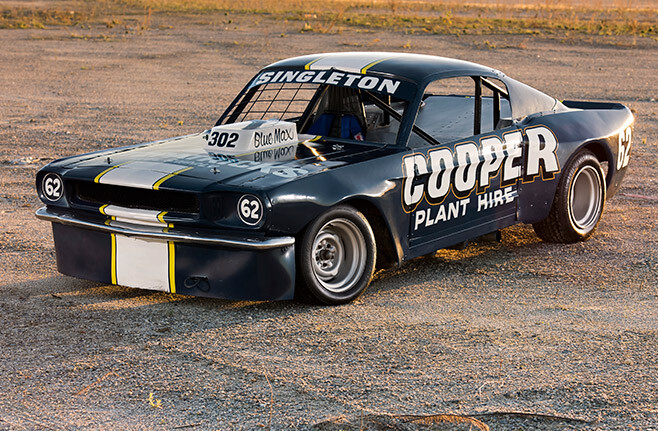 It’s been resurrected by Brian McDonough, a hot rodder, speedway fan and Mustang aficionado – as in, he judges concours ’Stangs – and Mick Thomspon, one of WA’s earliest hot rodders and a long-serving crew member with several speedway teams. Between them, they’ve made the car better than it ever was, but kept it true to the spirit it had when it raced through much of the 70s and 80s at Perth’s legendary Claremont Speedway.
It’s been resurrected by Brian McDonough, a hot rodder, speedway fan and Mustang aficionado – as in, he judges concours ’Stangs – and Mick Thomspon, one of WA’s earliest hot rodders and a long-serving crew member with several speedway teams. Between them, they’ve made the car better than it ever was, but kept it true to the spirit it had when it raced through much of the 70s and 80s at Perth’s legendary Claremont Speedway.
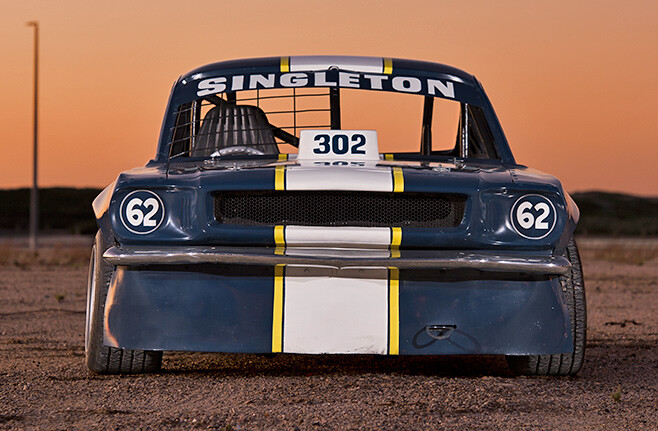 “It started off in about 1972 when Tony Pernechele from Bright Shine Wreckers had it; he brought it down from Exmouth,” Brian explains. “It was a six-cylinder then with a three-speed manual that’s still in it. Eventually they put a 250 2V in it with three Webers, and then Barry Blake bought it, cut the front out of an XW Falcon and put that suspension on the car – the towers and everything. It was all steel, but they’d smashed the front out of it and ‘beautifully’ flared the guards.”
“It started off in about 1972 when Tony Pernechele from Bright Shine Wreckers had it; he brought it down from Exmouth,” Brian explains. “It was a six-cylinder then with a three-speed manual that’s still in it. Eventually they put a 250 2V in it with three Webers, and then Barry Blake bought it, cut the front out of an XW Falcon and put that suspension on the car – the towers and everything. It was all steel, but they’d smashed the front out of it and ‘beautifully’ flared the guards.”
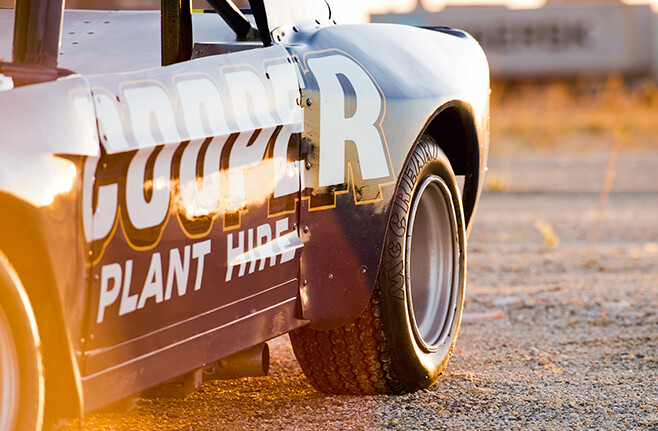 The car was then purchased by John Singleton, a mechanic at Lynford Motors. Brian had done his apprenticeship under Singleton, which is why he chose to restore it back to that version. But after John owned it the car was still to go through another couple of owners and incarnations before being almost lost and mostly forgotten in a suburban backyard.
The car was then purchased by John Singleton, a mechanic at Lynford Motors. Brian had done his apprenticeship under Singleton, which is why he chose to restore it back to that version. But after John owned it the car was still to go through another couple of owners and incarnations before being almost lost and mostly forgotten in a suburban backyard.
“After Singo raced it, Graeme Clarke – who was one of his pit crew – raced it and then Les North bought it, painted it white with blue stripes and changed it to #97. Northy sold it to the bloke that I bought it from, who took it home, tore it all apart and that was it,” Brian says.
That makes it all sound way too easy; it actually took a fair bit of detective work on Brian’s part to track the car down. After all, it had been missing for the better part of three decades. “I heard a rumour the car was around somewhere and because it was a Mustang I just had to have it,” he says. “So I went around and spoke to everyone I knew who was into speedway, and Mick did the same, and then we finally got onto Les North, and up on the wall [in his house] there was a photo of the car.”
Les drew up a bit of a mud map of where he thought the then-current owner lived, and Brian went around there with a bunch of photos of some of the cars he’d built. With luck on his side, the owner was still in the same place: “I chatted to the guy for quite a while, but he was really funny about it and didn’t act like he had anything; you couldn’t see anything from the front of his house,” Brian says. “We were probably talking for about 40 minutes or so and he said: ‘Oh well, you better come and have a look at it then.’
“It was left right where he’d parked it 30 years ago. He said: ‘It’s not for sale.’ I said I’d love to restore it and after a while he said: ‘What do you reckon it’s worth?’ I said not much because there wasn’t much of it left and he said: ‘Would you give me $1400 for it?’”
As you can imagine, even for a beat-up old Mustang, that was pretty good buying, so Brian let out a resounding “Hell yeah!” before jumping in the car to go and get the trailer. “I was straight back to Mick’s at 100mph, came back with the trailer and put it straight on before the guy changed his mind!”
Thirty years half-covered with a tarp held down with a couple of tyres and a radiator hadn’t done the car any favours, and to make things worse, it didn’t have a back end in it, so it was sitting in sand. The combination of rain coming in from the top and the wet soil working from below meant the poor old ’Stang was copping it from both sides.
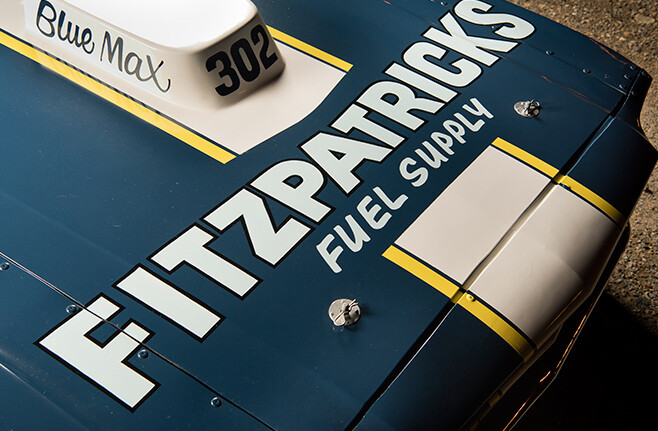 “The floor was in it when we found it, but it was that rotten that it just wasn’t worth mucking around with, so Mick said we might as well cut it out. The car’s been butchered up that much it didn’t matter if we changed it a little bit. It’s still got the Falcon towers and suspension, but Mick made an all-new crossmember and bracing under there and repaired all the chassis.”
“The floor was in it when we found it, but it was that rotten that it just wasn’t worth mucking around with, so Mick said we might as well cut it out. The car’s been butchered up that much it didn’t matter if we changed it a little bit. It’s still got the Falcon towers and suspension, but Mick made an all-new crossmember and bracing under there and repaired all the chassis.”
While the car has been restored to appear as close as possible to how it was raced by John Singleton, it’s not an exact re-creation. Partially because a lot of it was pretty rooted, and also because Brian wanted to actually get the car out on the track and Mick knew how to make it handle a lot better than it ever did. “We’ve modified it a bit; I just went on Mick’s terms,” Brian says. “He just said: ‘It’s not going to handle properly if you don’t do this, this and this.’ So we rearranged the back end and did a bit of stuff similar to what Leo Gommers used to do. It handles like a dream, it’s just beautiful.
“When you jab the brake, it just throws it sideways, gets you a good lead into the corner. It’s not real good on the road, but it’s still pretty good. You steer it with the back tyres because it’s got 5.67 gears in it, so it’s pretty revvy, and it goes like buggery!”
That was another departure from full race spec: putting in a more user-friendly engine. Originally the car raced with a mechanically injected methanol engine, but Brian didn’t want the hassle and maintenance with that kind of combo when he was only going to be using the car a few times a year. “I’ve got the original fuel injection and I’m going to restore it all, but I’ll just keep it. I’ve put Webers on it because it’s the same look but it’s so reliable and easy, just on petrol. We’re not allowed to race, we’re only allowed to do demonstrations.”
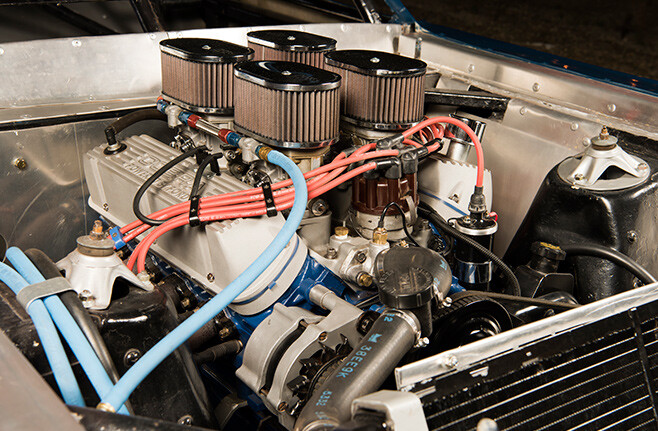 The car also runs a regular gearbox, the one it left the factory with, not an in-or-out dog box. “That’s the advantage with having a gearbox, a clutch and a starter motor – I can just drive it on and off the trailer. It’s a matching-numbers gearbox!” Brian laughs. “I pulled the gearbox apart; I put front and rear bearings in it, but it was like brand new because it only ever ran in top gear.”
The car also runs a regular gearbox, the one it left the factory with, not an in-or-out dog box. “That’s the advantage with having a gearbox, a clutch and a starter motor – I can just drive it on and off the trailer. It’s a matching-numbers gearbox!” Brian laughs. “I pulled the gearbox apart; I put front and rear bearings in it, but it was like brand new because it only ever ran in top gear.”
Proving that speedway racers were all hot rodders at heart, the Mustang used to have a Chev 10-bolt diff in it, because, according to Brian, “in the old days, they had more ratios and they were easier to get. But it’s had a nine-inch in it for a long time.”
The Mustang also has a connection with street machine royalty, with the fibreglass panels being fabricated by Jeff and Mark Allen, the same father-and-son team that worked on XBOSS: “Every owner kept the moulds; they were a bit ugly but they did the job. Mick and myself made the mould for the grille and we modified the bonnet. The guards and door panels are similar to a ’69, which I think are probably the same moulds that Stan Starcevich used when he built his one. That’s why it’s got the ducktail at the back.”
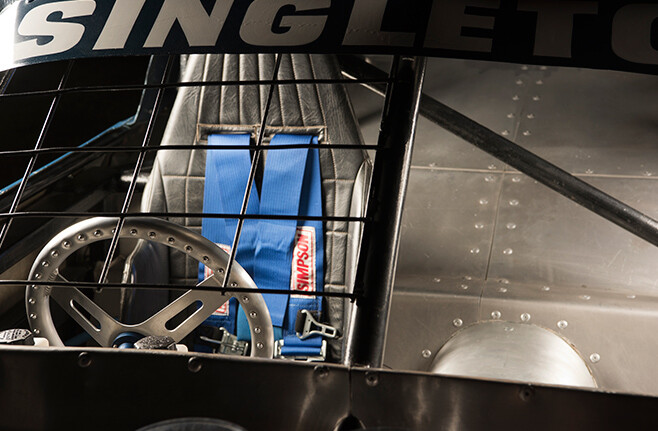 It might not be the most highly detailed car we’ve had in the pages of , and it sure as shit won’t win any prizes for panel and paint, but there’s something special about old race cars that were once someone’s prized possession, that actually cruised the streets like every other car, as opposed to some purpose-built, tube-framed racing machine with stickers for headlights.
It might not be the most highly detailed car we’ve had in the pages of , and it sure as shit won’t win any prizes for panel and paint, but there’s something special about old race cars that were once someone’s prized possession, that actually cruised the streets like every other car, as opposed to some purpose-built, tube-framed racing machine with stickers for headlights.
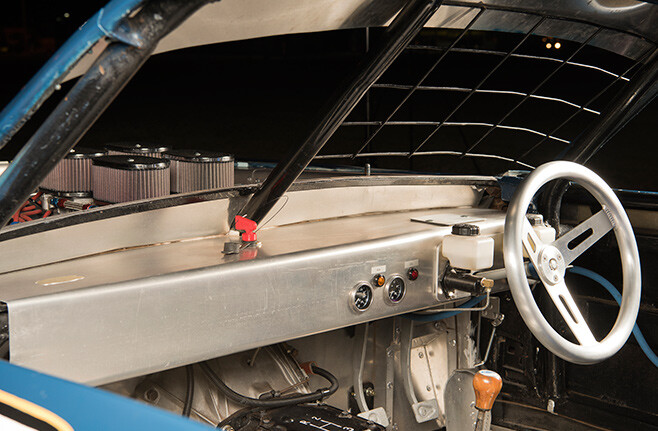 As for John Singleton these days? He’s retired and living in Mandurah, and Brian catches up with him quite often: “When I first bought the car I didn’t realise this was the one he had a hand in. After I tracked all the owners down I rang John and he remembered me, so he came up and had a look at it. He got a bit teary. I think he misses it.”
As for John Singleton these days? He’s retired and living in Mandurah, and Brian catches up with him quite often: “When I first bought the car I didn’t realise this was the one he had a hand in. After I tracked all the owners down I rang John and he remembered me, so he came up and had a look at it. He got a bit teary. I think he misses it.”
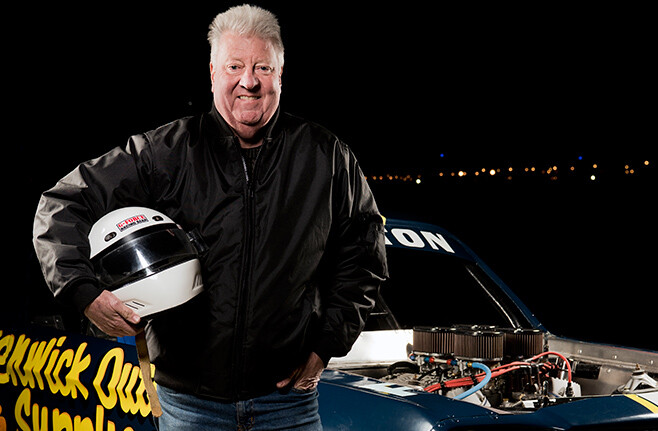 BRIAN McDONOUGH
BRIAN McDONOUGH
1965 MUSTANG FASTBACK
Colour: Ocean Blue enamel
DONK
Type: 302 Mexico block
Inlet: Ford Shelby quad-Weber
Carb: Four Weber 48 IDFs
Heads: Dart iron heads
Cam: Solid-roller
Radiator: XB Falcon
Exhaust: DJR four-into-one headers
Ignition: Bosch twin-point
SHIFT
’Box: Three-speed manual
Diff: 9in
BENEATH
Front end: XW Falcon, adjustable sway-bar
Springs: HD springs (f), leaf (r)
Shocks: Gas
Steering: XC Falcon power steering
Brakes: Wilwood discs (front left & right rear)
ROLLING STOCK
Rims: Widened steelies; 15×8 (f), 15×10 (left rear), 15×11 (right rear)
Rubber: BFG Euro T/A 225/50/15 (f), McCreary 82.0/8.0-15 (left rear), Firestone 6.00/12.30-15 (right rear)
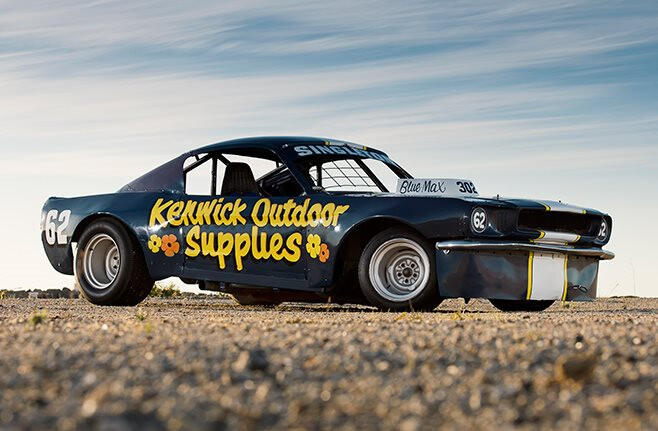
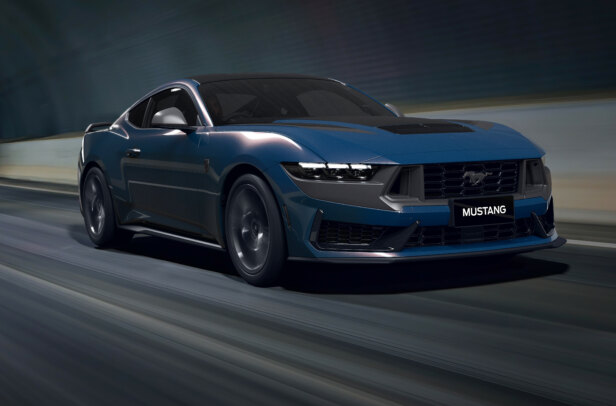
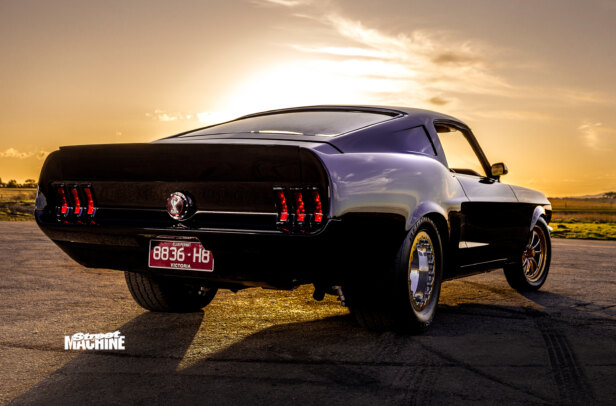
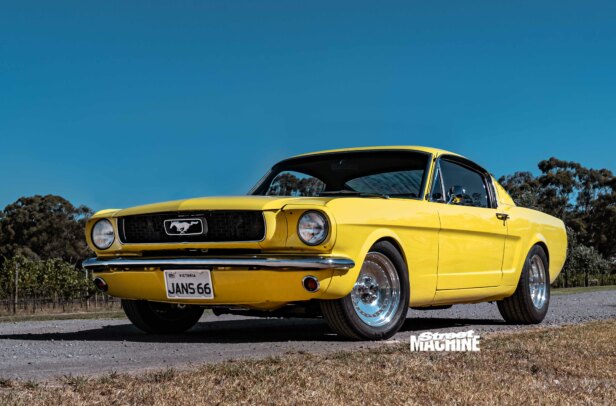
Comments